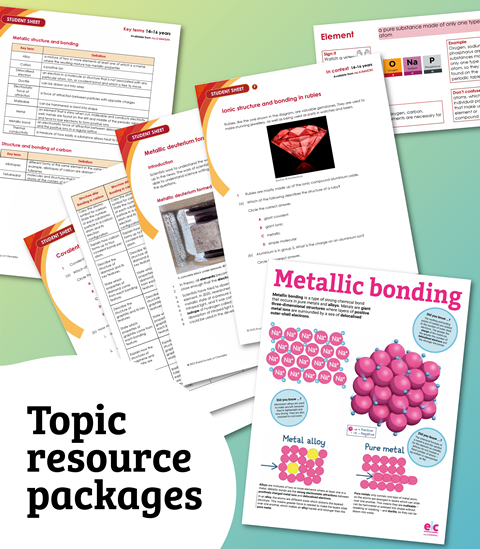All Structure and bonding articles – Page 14
-
 Feature
FeatureRise of molecular machines
Chemists are putting molecules to work in ways only limited by our imagination
-
 Resource
ResourceStructure and Bonding
Knowledge of structure and bonding can help explain the properties of materials. All the properties of a particular substance depend upon the elements present and how they are bonded to each other. This programme is designed to develop students understanding of structure and bonding as well as developing thinking ...
-

-

-

-
 Resource
Resource28 chemistry puzzles for 14-16 years
Use these sudoku-inspired puzzles with printable worksheets and answers to help 14–16 year olds consolidate their understanding of key chemical concepts.
-
 Resource
Resource45 chemistry puzzles for 16-18 years
Try these chemistry puzzles based on sudoku to help 16–18 year old students consolidate their knowledge about key topics, with printable worksheets and answers.
-

-
 Soundbite
SoundbiteXenon dioxide
Simon Cotton takes a look at those compounds that find themselves in the news or relate to our everyday lives.
-
 Feature
FeatureChemical Bonding
A masterclass in teaching the topic of bonding, basing chemical explanation on physical forces
-
 Feature
FeatureInvestigating Crystal Structures
Sixthformers are introduced to Madelung constants as a way of investigating ionic crystal structures
-
 Exhibition chemistry
Exhibition chemistrySoap from bacon - the dangers of alkaline solutions
Demonstrations designed to capture the student's imagination
-
 Feature
FeatureIf it smells - it's chemistry
Smell is the most chemical of all the senses - but what's the theory behind the practice?
-
 Lesson plan
Lesson planAtoms and atomic structure: a ‘similar and different’ activity | 16-18 years
Help students consolidate their ideas about atoms and atomic structure, working in pairs to identify key concepts, using this lesson plan for 16–18 year olds.
-
 Lesson plan
Lesson planLinking structure, bonding and substance properties | 16-18 years
Check students’ understanding of how properties of substances depend on their structure and bonding using this lesson plan with activities for 16–18 year olds.
-
 Lesson plan
Lesson planPlastics and polymers: their structure and properties | 16-18 years
Explore how the properties of polymers depend on their structure and different types of intermolecular bonds using this lesson plan for 16–18 year olds.
-
 Lesson plan
Lesson planTransition metal complexes and ligand exchange | 16-18 years
Try this lesson plan for 16–18 year olds to support your students to research transition metal complexes, including shape, naming, bonding and ligand exchange.
-
 Lesson plan
Lesson planWhat are crystals and how are they structured? | 11-14 years
Discover the regular structure and arrangement of particles in crystalline substances using this lesson plan with activities for 11–14 year olds.
-
 Lesson plan
Lesson planWhat are hydrogen bonds? | 16-18 years
Help students explore hydrogen bonding and discover where hydrogen bonds are found using this lesson plan with activities for 16–18 year olds.
-
 Lesson plan
Lesson planHow do atoms form the ions in ionic compounds? | 16-18 years
Check students’ understanding of why atoms form ions, and how ionic compounds form by ionic bonding, using this lesson plan with activities for 16–18 year olds.











